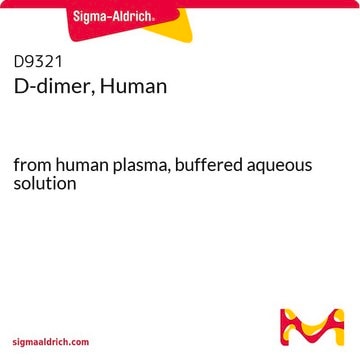F5386
Fibrin from human plasma
insoluble powder
About This Item
Produits recommandés
Description générale
Application
- for in vitro cleavage of fibrinogen and fibrin
- as a reference for true component analysis (TCA) and principal component analysis (PCA) of Raman spectra
- as a reference in Raman spectroscopy to study the binding mechanisms and the binding efficiency of the different polyoxometalates (POMs)
Actions biochimiques/physiologiques
Notes préparatoires
Clause de non-responsabilité
Code de la classe de stockage
11 - Combustible Solids
Classe de danger pour l'eau (WGK)
WGK 3
Point d'éclair (°F)
Not applicable
Point d'éclair (°C)
Not applicable
Certificats d'analyse (COA)
Recherchez un Certificats d'analyse (COA) en saisissant le numéro de lot du produit. Les numéros de lot figurent sur l'étiquette du produit après les mots "Lot" ou "Batch".
Déjà en possession de ce produit ?
Retrouvez la documentation relative aux produits que vous avez récemment achetés dans la Bibliothèque de documents.
Les clients ont également consulté
Articles
Cell based angiogenesis assays to analyze new blood vessel formation for applications of cancer research, tissue regeneration and vascular biology.
Highlighting existing and novel fabrication methods for both, solid and hydrogel-based scaffold for tissue engineering applications.
Hydrogel-based biomaterials for cell delivery and tissue regeneration applications are discussed.
Notre équipe de scientifiques dispose d'une expérience dans tous les secteurs de la recherche, notamment en sciences de la vie, science des matériaux, synthèse chimique, chromatographie, analyse et dans de nombreux autres domaines..
Contacter notre Service technique









